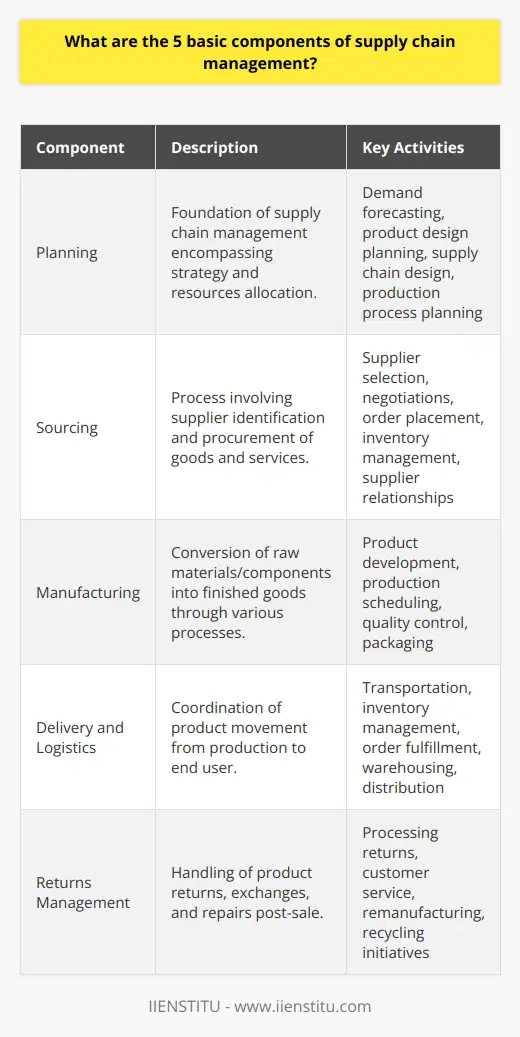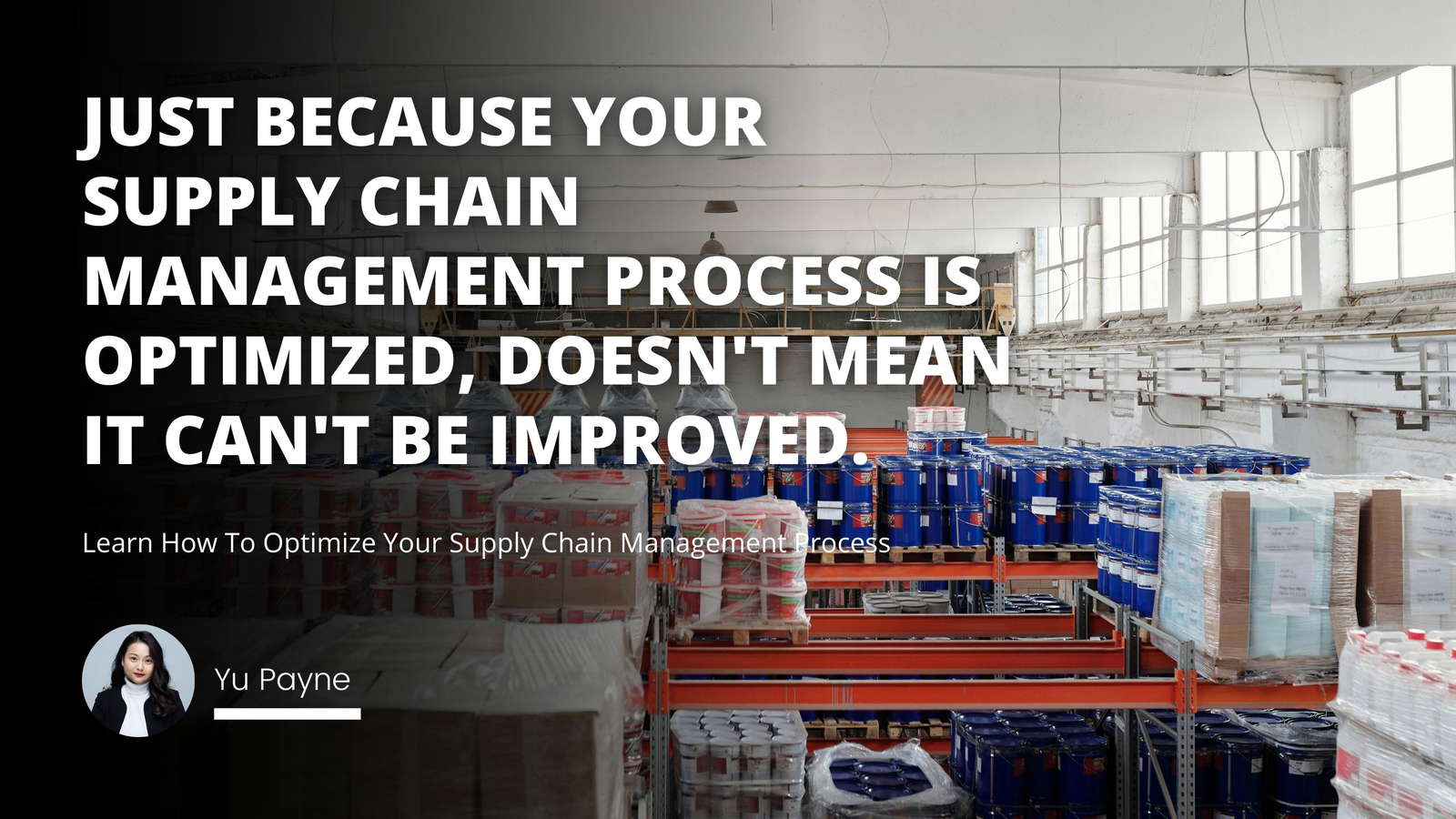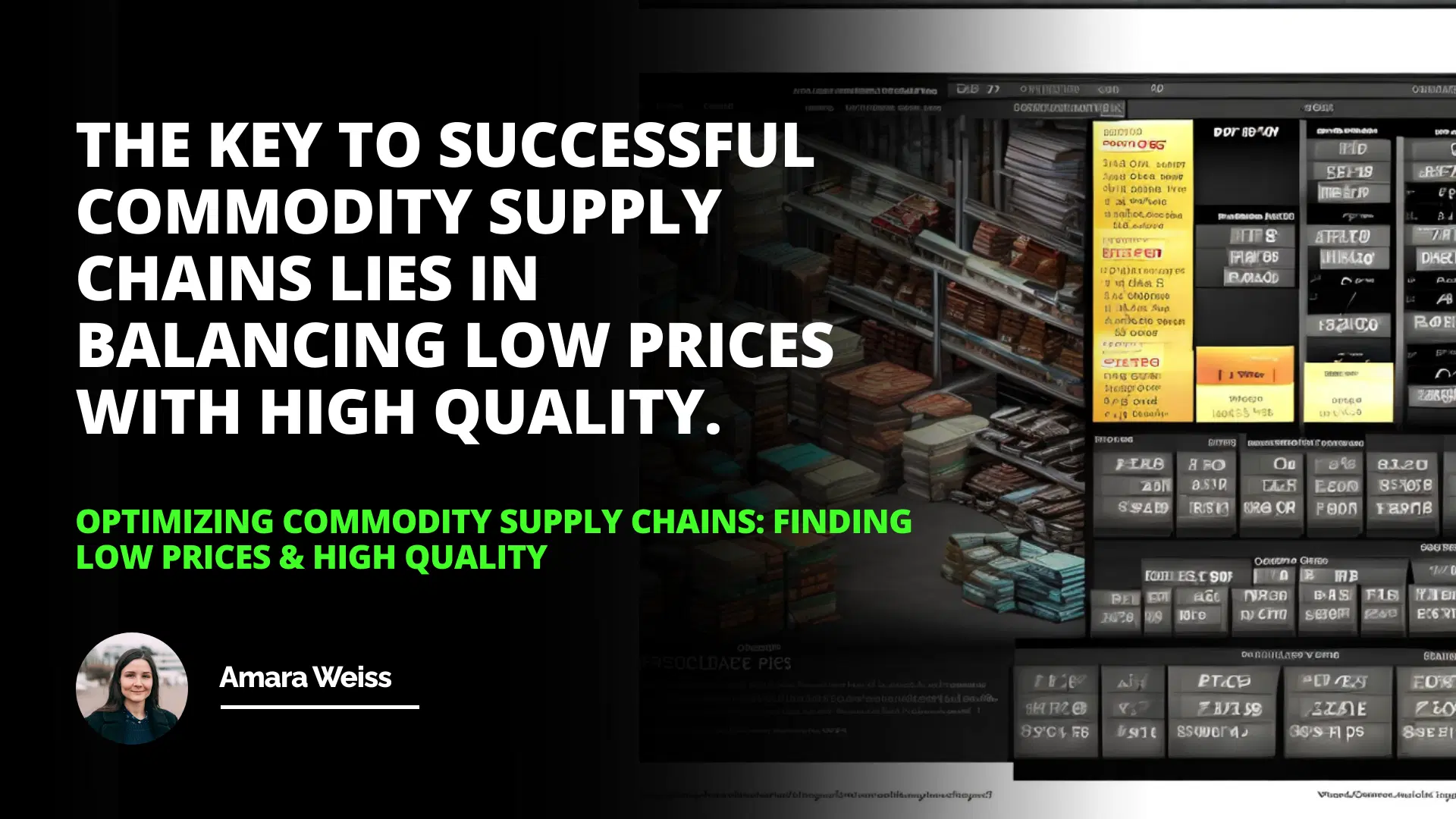
Strategies for Ensuring High-Quality in Commodity Supply Chains
In today's fast-paced business world, optimizing commodity supply chain strategies has become a critical factor in determining the success of companies across various industries. From agricultural products to raw materials, the efficient sourcing and management of commodities play a vital role in maintaining a competitive edge. However, the pursuit of low prices often overshadows the importance of quality, leading to potential risks and challenges in the long run.
As someone who has worked in the supply chain management industry for over a decade, I have witnessed firsthand the consequences of prioritizing cost over quality. In one particular instance, a manufacturing company I worked with decided to switch to a cheaper supplier for a key component in their production process. While the initial savings were substantial, the quality of the components quickly deteriorated, leading to a surge in defective products and customer complaints. The company ended up losing more money in the long run due to the costs associated with recalls, repairs, and damaged reputation.
Introduction
The Challenges of Optimizing Commodity Supply Chains
Strategies for Finding Low Prices
Strategies for Ensuring High Quality
Conclusion
This experience taught me a valuable lesson: quality control in supply chain management is not something to be compromised. It is essential to establish a robust system for supplier monitoring and quality assurance to ensure that the commodities sourced meet the required standards consistently.
One of the most effective strategies for sourcing commodity goods is to develop long-term partnerships with reliable suppliers. By fostering strong relationships built on trust and transparency, companies can work closely with their suppliers to ensure that quality standards are met at every stage of the supply chain. This approach not only reduces the risk of quality issues but also allows for greater flexibility and responsiveness in the face of changing market conditions.
Another crucial aspect of ensuring quality in commodity supply chains is the implementation of rigorous quality control measures. This includes regular inspections, testing, and audits to verify that the commodities received meet the specified requirements. By investing in advanced quality control technologies and trained personnel, companies can detect and address quality issues promptly, minimizing the impact on their operations and customers.
However, implementing these quality control measures can be challenging, particularly in the context of low-cost strategies for commodities. The pressure to reduce costs often leads companies to cut corners when it comes to quality assurance, which can have disastrous consequences in the long run. It is essential to strike a balance between cost efficiency and quality, recognizing that the true cost of poor quality far outweighs any short-term savings.
To achieve this balance, companies must adopt a holistic approach to supply chain management, considering not just the price of commodities but also the total cost of ownership. This includes factors such as transportation costs, inventory carrying costs, and the potential costs associated with quality issues. By taking a comprehensive view of the supply chain, companies can make informed decisions that optimize both cost and quality.
Effective supplier communication is another key factor in ensuring quality in commodity supply chains. Clear and consistent communication helps to align expectations, resolve issues promptly, and foster a culture of continuous improvement. By establishing open channels of communication and regularly engaging with suppliers, companies can proactively address quality concerns and work together to find solutions.
In addition to these strategies, companies can also benefit from adopting best practices for commodity supply chains from industry leaders and experts. For example, the "deep focus" techniques discussed in Newport's Deep Work can be applied to supply chain management, allowing teams to concentrate on critical tasks and make more informed decisions (Newport, 2016). Similarly, research on the effectiveness of the Pomodoro Technique, as outlined in Francesco Cirillo's book of the same name, can help supply chain professionals manage their time more efficiently and maintain focus on quality-related tasks (Cirillo, 2018).
Long Tail Keyword: Decision Support Systems For Efficient Production And Distribution Planning
How To Optimize İnbound Logistics For Reduced İnventory Costs
Moreover, insights from academic papers on cognitive load theory can help supply chain managers understand the mental demands placed on their teams and design processes that minimize the risk of errors and oversights (Sweller et al., 2011). By leveraging these diverse sources of knowledge, companies can develop a more comprehensive and effective approach to quality assurance in commodity supply chains.
The key to successful commodity supply chains lies in balancing low prices with high quality.

However, it is important to recognize that ensuring quality in commodity supply chains is not a one-time exercise but an ongoing process that requires continuous monitoring, evaluation, and improvement. As market conditions evolve and new challenges emerge, companies must remain agile and adaptable, constantly seeking ways to optimize their supply chain strategies while maintaining a strong focus on quality.
One of the key challenges in commodity supply chain optimization is the inherent volatility and uncertainty of commodity markets. Prices can fluctuate rapidly based on a variety of factors, such as weather conditions, geopolitical events, and changes in supply and demand. This volatility can make it difficult for companies to plan and budget effectively, as well as to maintain consistent quality levels.
To mitigate these risks, companies must develop robust risk management strategies that take into account the unique characteristics of commodity markets. This may involve diversifying suppliers, hedging against price fluctuations, and building flexibility into supply chain processes to allow for rapid adaptation to changing conditions.
Another key challenge is the increasing complexity of global commodity supply chains. With suppliers and customers located around the world, companies must navigate a complex web of regulations, cultural differences, and logistical challenges. This complexity can make it difficult to maintain visibility and control over the entire supply chain, increasing the risk of quality issues and supply disruptions.
To address these challenges, companies must invest in advanced supply chain technologies and analytics that provide real-time visibility and insights into the flow of commodities. By leveraging tools such as blockchain, the Internet of Things (IoT), and artificial intelligence (AI), companies can gain greater transparency and traceability throughout the supply chain, enabling them to identify and address quality issues more quickly and effectively.
In conclusion, ensuring high-quality in commodity supply chains requires a multifaceted approach that balances cost efficiency with robust quality control measures. By developing strong supplier partnerships, implementing rigorous quality assurance processes, and adopting best practices from industry leaders and experts, companies can optimize their commodity supply chain strategies while maintaining a strong focus on quality. However, this is an ongoing process that requires continuous monitoring, evaluation, and improvement in the face of evolving market conditions and challenges.
As the business landscape continues to change and new technologies emerge, it is crucial for companies to remain agile and adaptable in their approach to supply chain management. By staying at the forefront of industry trends and best practices, companies can position themselves for long-term success in the increasingly competitive world of commodity supply chains.
References:
Cirillo, F. (2018). The Pomodoro Technique: The Acclaimed Time-Management System That Has Transformed How We Work. Currency.
Newport, C. (2016). Deep Work: Rules for Focused Success in a Distracted World. Grand Central Publishing.
Sweller, J., Ayres, P., & Kalyuga, S. (2011). Cognitive Load Theory. Springer.
Frequently Asked Questions
What strategies can be employed to optimize commodity supply chains in order to find low prices?
Supply chain optimization has become an increasingly important factor in finding low prices for commodities. By optimizing a supply chain, companies can reduce costs and increase profitability. This article discusses a few strategies that can be employed to optimize commodity supply chains in order to find low prices.
The first strategy is to use the right inventory management system. Inventory management systems can help companies identify the most cost-effective sources of commodities and track their supply chains. By utilizing inventory management systems, companies can ensure that their supply chains are running efficiently and optimally.
The second strategy is to use data-driven decision making. Companies should use data-driven decision making to make decisions about the supply chain. By analyzing data, such as cost of goods, transportation costs, and demand, companies can determine the best sources of commodities and optimize their supply chain.
The third strategy is to leverage technology. Companies can use technology to optimize their supply chains. Technology can be used to automate processes, track the supply chain, and optimize the logistics of the supply chain. This can lead to improved efficiency and reduced costs.
The fourth strategy is to collaborate with suppliers. By collaborating with suppliers, companies can gain access to better prices for commodities. Companies can negotiate better prices with suppliers, as well as create partnerships that can benefit both parties.
The fifth strategy is to use predictive analytics. Predictive analytics can help companies identify potential supply chain disruptions and identify opportunities for cost savings. By using predictive analytics, companies can be better prepared to respond to supply chain disruptions and ensure that their supply chains are optimized.
These are just a few strategies that can be employed to optimize commodity supply chains in order to find low prices. By utilizing these strategies, companies can reduce costs, increase efficiency, and increase profitability.

How can organizations ensure high quality when optimizing commodity supply chains?
Organizations must continuously work to optimize their commodity supply chains in order to remain competitive. However, ensuring high quality during the optimization process is of paramount importance. Quality is a critical factor for customer satisfaction, and organizations must ensure that it is not compromised as they strive to optimize their supply chains.
The first step in ensuring high quality as an organization optimizes its commodity supply chain is to review existing processes and identify areas where improvements can be made. This may involve analyzing current processes to determine which activities could be automated or streamlined. Organizations should also identify any potential risks or inefficiencies that could affect quality, and develop strategies to minimize or eliminate them.
In addition to reviewing existing processes, organizations should also review the quality of their suppliers. Organizations should ensure that suppliers meet or exceed their quality standards. This can be done by establishing clear quality standards, regularly monitoring supplier performance, and working collaboratively with suppliers to identify areas where quality can be improved.
Organizations should also take steps to ensure that their supply chain partners are able to meet their quality requirements. This may involve conducting regular audits of partner facilities, ensuring that appropriate processes and procedures are in place to ensure quality, and providing training to partner personnel. Additionally, organizations should consider the use of technology such as blockchain, which can be used to track the quality of products as they move through the supply chain.
Finally, organizations should ensure that their supply chain personnel are trained in quality management. This can involve providing training in topics such as quality assurance, quality control, and process improvement. Additionally, organizations should ensure that their personnel are equipped with the necessary tools and techniques to effectively monitor and manage quality.
In summary, organizations must take a proactive approach to ensuring high quality when optimizing their commodity supply chains. This involves reviewing existing processes and suppliers, ensuring that supply chain partners are able to meet quality requirements, and providing quality management training to personnel. By taking these steps, organizations can ensure that high quality is maintained as they strive to optimize their supply chains.

What are the challenges associated with optimizing commodity supply chains to find low prices and ensure high quality?
The optimization of a commodity supply chain to find low prices and ensure high quality is a complex process that is faced with numerous challenges. These challenges can be categorized into the following categories: financial, technological, and logistical.
From a financial perspective, there are challenges associated with cost optimization in commodity supply chains. This includes finding ways to reduce the costs of raw materials, labor, and other costs associated with production. Additionally, the optimization of commodity prices themselves presents a challenge, as prices can fluctuate significantly depending on market conditions.
From a technological standpoint, there are challenges associated with the use of technology in the optimization of commodity supply chains. For example, the use of predictive analytics to ensure accurate pricing and quality control is a complex process that requires the integration of multiple data sources. Additionally, the use of automation and machine learning in supply chain optimization presents challenges related to the reliability of the technology and the ability to properly manage and maintain it.
Finally, there are logistical challenges associated with optimizing commodity supply chains. This includes the need for efficient and accurate inventory management, as well as the ability to source and deliver goods in a timely manner. Additionally, logistics optimization requires the ability to properly track and trace shipments and ensure that goods arrive in the right condition.
In conclusion, the optimization of a commodity supply chain to find low prices and ensure high quality is a complex process that is faced with numerous challenges. These challenges can be categorized into the financial, technological, and logistical realms. By understanding and addressing these challenges, organizations can ensure that their commodity supply chains are optimized for efficiency and quality.

What are the key factors to consider when optimizing supply chain costs while maintaining high quality?
Operational Efficiency
The first key factor to consider is operational efficiency, which refers to the effectiveness of managing production and delivery processes. It is crucial to plan resources and inventory optimally, as well as streamline the supply chain to reduce unnecessary costs. Continuous improvement and regular monitoring of supply chain performance contribute to achieving optimal efficiency.
Supplier Collaboration
Strong relationships with suppliers are vital for maintaining high quality while optimizing supply chain costs. Collaborating closely with suppliers can help companies achieve competitive prices for materials, negotiate better payment terms, and ensure timely delivery of goods. Developing transparent communication and collaboration strategies can enhance the performance of the supply chain in terms of cost, quality, and speed.
Risk Management
Managing risks effectively is essential for optimizing supply chain costs without compromising quality. Identifying potential risks, such as natural disasters, geopolitical tensions, or supplier failures, can help companies develop contingency plans that minimize disruption to the supply chain. Companies should continuously assess market trends, evaluate their suppliers' performances, and execute mitigation strategies to minimize potential supply chain risks.
Technology Integration
Leveraging technology in supply chains can help companies optimize costs while maintaining high quality. By implementing advanced technologies such as blockchain, artificial intelligence, and data analytics, companies can improve end-to-end visibility, predict demand more accurately, and minimize stockouts and overstock issues. These technologies also enable companies to identify inefficiencies, making data-driven decisions that can positively impact supply chain performance.
Sustainability Practices
Investing in sustainable practices is essential for managing supply chain costs while maintaining high quality. By adopting green initiatives, such as using eco-friendly packaging and cleaner transportation methods, companies can minimize their environmental footprint, reduce waste, and optimize the use of resources. Sustainable practices can lead to long-term cost savings, improved brand reputation, and increased customer satisfaction.
In conclusion, optimizing supply chain costs while maintaining high quality requires a holistic approach that addresses operational efficiency, supplier collaboration, risk management, technology integration, and sustainability practices. By focusing on these key factors, companies can develop a robust and cost-effective supply chain strategy that delivers value to all stakeholders.
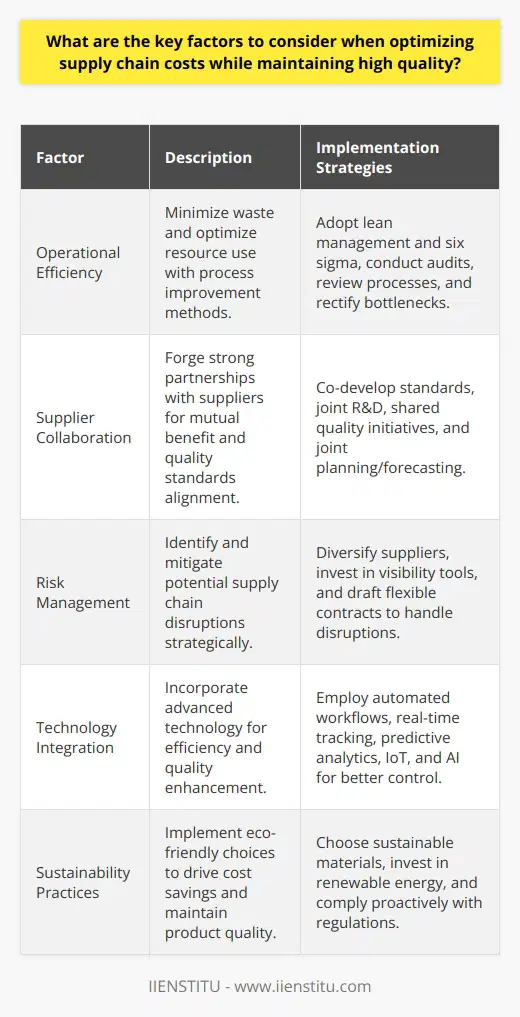
How do supply chain strategies vary according to business objectives and markets?
Supply Chain Strategies and Business Objectives
Effective supply chain strategies must be aligned with the specific business objectives and target markets of an organization to ensure efficiency and competitiveness. These strategies are shaped by a range of factors that influence their design and implementation, with the most noticeable variations arising in the areas of production and sourcing, distribution and logistics, and the role of technology.
Production and Sourcing
When formulating supply chain strategies, companies must consider their production and sourcing approaches in the context of their business objectives. Some businesses prioritize cost efficiency and seek cost-effective production methods and sources of raw materials, such as global outsourcing. On the other hand, companies emphasizing quality or sustainable practices may prioritize domestic or regional sourcing to maintain tighter control over production processes and support local economies. Decisions regarding production and sourcing directly impact the supply chain and its overall performance.
Distribution and Logistics
Similarly, distribution and logistics strategies need to be tailored to match the objectives and target markets of a business. For instance, companies targeting clients with urgent delivery requirements might prioritize expedited shipping methods, necessitating a highly responsive and efficient distribution network. In contrast, those operating in niche markets with more patient clientele might focus on optimizing their shipping routes to minimize transportation costs. Customized distribution and logistics strategies help companies to address the unique needs and preferences of their customers, providing a competitive advantage.
Role of Technology
Finally, technology plays a critical role in shaping supply chain strategies. Companies embracing digital transformation benefit from increased visibility, streamlined operations, and enhanced decision-making capabilities, thereby aligning their supply chain with their overall strategic objectives. For example, businesses focused on enhancing customer experiences may invest in advanced tracking systems and e-commerce platforms, while companies with sustainability goals tend to adopt technologies and data analytics tools to minimize waste and drive efficiencies.
In conclusion, supply chain strategies vary significantly in response to differing business objectives and target markets, as companies need to align their supply chain design and execution with their overall strategic goals. This alignment fosters better decision-making, resource allocation, and customization, allowing businesses to optimize their supply chains according to their specific needs and priorities.
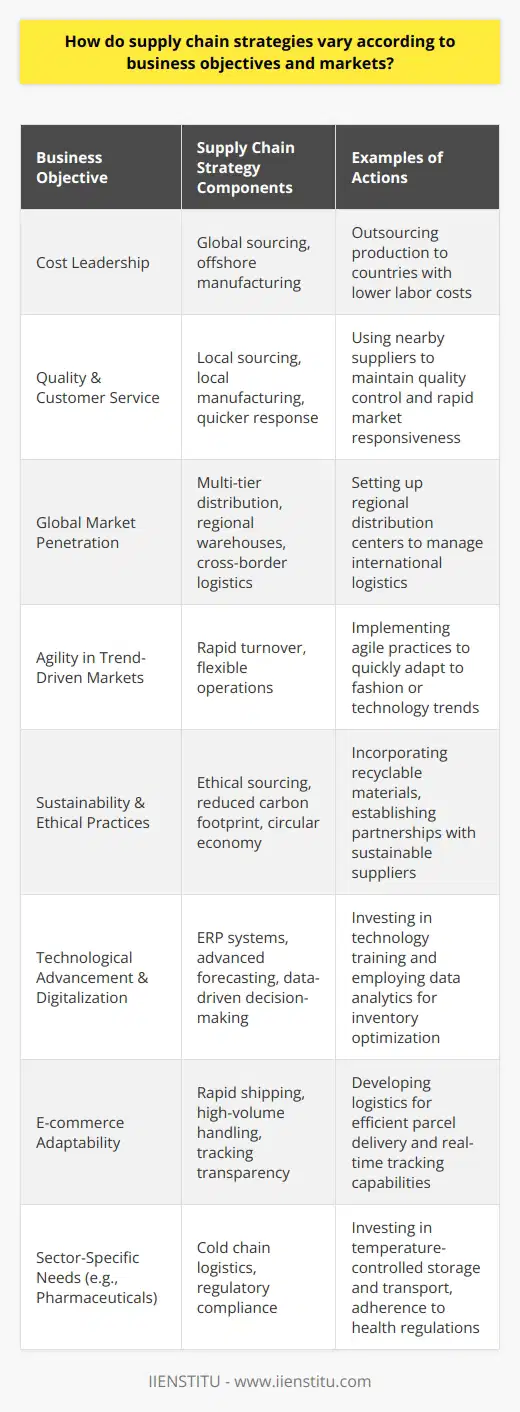
What are the implications of overall supply chain optimization on business performance and sustainability?
Impact on Business Performance
Overall supply chain optimization has significant implications on the performance of a business, as it encompasses improving efficiency, cost reduction, and customer satisfaction. By streamlining the flow of products and information through the integration of suppliers, manufacturers, distributors, and retailers, businesses can minimize operational costs and achieve maximum resource utilization. This improved efficiency aids in faster lead times and timely deliveries, directly enhancing customer satisfaction and loyalty.
Influence on Sustainability
The pursuit of overall supply chain optimization also emphasizes the need to incorporate sustainability principles in business operations. A sustainable supply chain focuses on addressing the long-term social, environmental, and economic impacts of its activities. By optimizing the supply chain, companies can lower their ecological footprint through the efficient use of materials, reduction of waste, and careful allocation of resources. In turn, these environmentally conscious practices contribute to a better public image and stronger brand reputation, attracting conscious consumers and investors.
Role of Technology and Innovation
Implementing cutting-edge technologies and fostering a culture of innovation are important drivers for achieving overall supply chain optimization. Technologies such as artificial intelligence, the Internet of Things, and blockchain can dramatically improve the accuracy and timeliness of data, enabling more informed decision-making processes. Moreover, embracing innovation challenges traditional processes, promotes creative thinking, and stimulates new product and service development, which ultimately improves the competitiveness and sustainability of a business.
Collaboration and Transparency
Effective communication, cooperation, and trust among supply chain partners are critical factors in achieving optimization. By promoting transparency and collaboration, businesses can work together to identify and address inefficiencies, find new market opportunities, and collectively cope with disruptions. This collaborative approach fosters long-term relationships and secures a stable and reliable network of partners, which directly contribute to improved business performance and sustainability.
Corporate Social Responsibility
Finally, an optimized supply chain not only maximizes profitability but also ensures that the business’s ethical conduct and adherence to corporate social responsibility (CSR) principles are maintained. This includes ensuring safe working conditions, fair labor practices, and ethical sourcing of raw materials. By prioritizing CSR initiatives, a company not only safeguards its reputation but also demonstrates its commitment to the well-being of its stakeholders and the environment.
In conclusion, overall supply chain optimization has crucial implications on both business performance and sustainability. By focusing on efficiency, technology, collaboration, and corporate social responsibility, businesses can enhance their competitiveness, reputation, and long-term viability, propelling them towards a more secure and prosperous future.
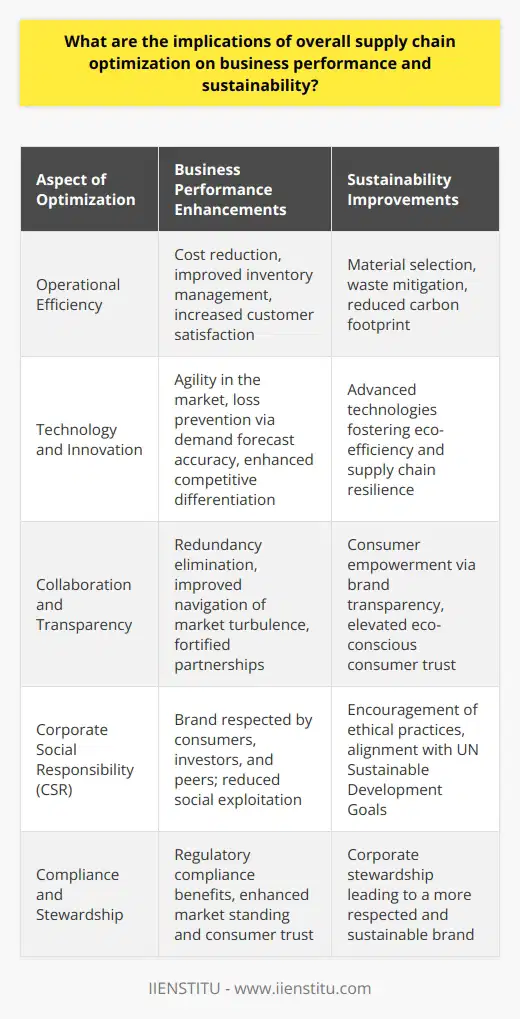
How do you achieve supply chain optimization?
Strategizing the Supply Chain
Achieving supply chain optimization is an essential process that requires a comprehensive blend of strategic and tactical approaches. The underlying objective remains to improve the overall performance of the supply chain in terms of cost, quality, and delivery.
Technology and Data Analysis
Utilizing advanced technologies, such as artificial intelligence (AI), Internet of Things (IoT), and data analytics, allows key stakeholders to make informed decisions. Leveraging predictive analytical tools can lead to better demand forecasting, inventory management, and capacity planning. These methods help in proactively identifying potential bottlenecks, reducing lead times, and minimizing costs.
Collaboration and Integration
Establishing close collaboration between different supply chain partners is vital for effective communication and information sharing. Effective communication between suppliers, manufacturers, and retailers can lead to improved coordination and risk-sharing. Integration of all supply chain processes into a single platform, such as Enterprise Resource Planning (ERP) or Supply Chain Management (SCM) systems, enables streamlined information flow, resulting in improved operational efficiency.
Lean and Agile Practices
Adapting to market changes by embracing lean and agile practices is vital for supply chain optimization. Lean methodologies focus on eliminating waste and non-value-added activities from the process, resulting in enhanced efficiency and cost reduction. Agile practices, on the other hand, allow organizations to rapidly respond to fluctuating customer demands and market trends.
Supplier and Logistics Management
Effective supplier management involves the systematic selection, evaluation, and monitoring of suppliers, with the goal of ensuring high quality goods and materials. Developing strong relationships with suppliers can lead to increased cooperation, risk reduction, and improved performance. Furthermore, efficient logistics management, including transportation, warehousing, and distribution operations, plays a crucial role in reducing lead times and ensuring on-time deliveries.
Continuous Improvement and Monitoring
A commitment to continuous improvement and performance monitoring is key in achieving supply chain optimization. By constantly tracking Key Performance Indicators (KPIs), such as order-to-delivery cycle times, inventory turns, and supplier lead times, organizations can identify areas for improvement and drive a culture of constant progress.
In conclusion, supply chain optimization can be achieved through a mixture of technological adoption, collaboration, lean and agile practices, effective management of suppliers and logistics, and a focus on continuous improvement. By carefully considering these factors, organizations can create a highly efficient, cost-effective, and responsive supply chain that meets the demands of today's highly competitive markets.
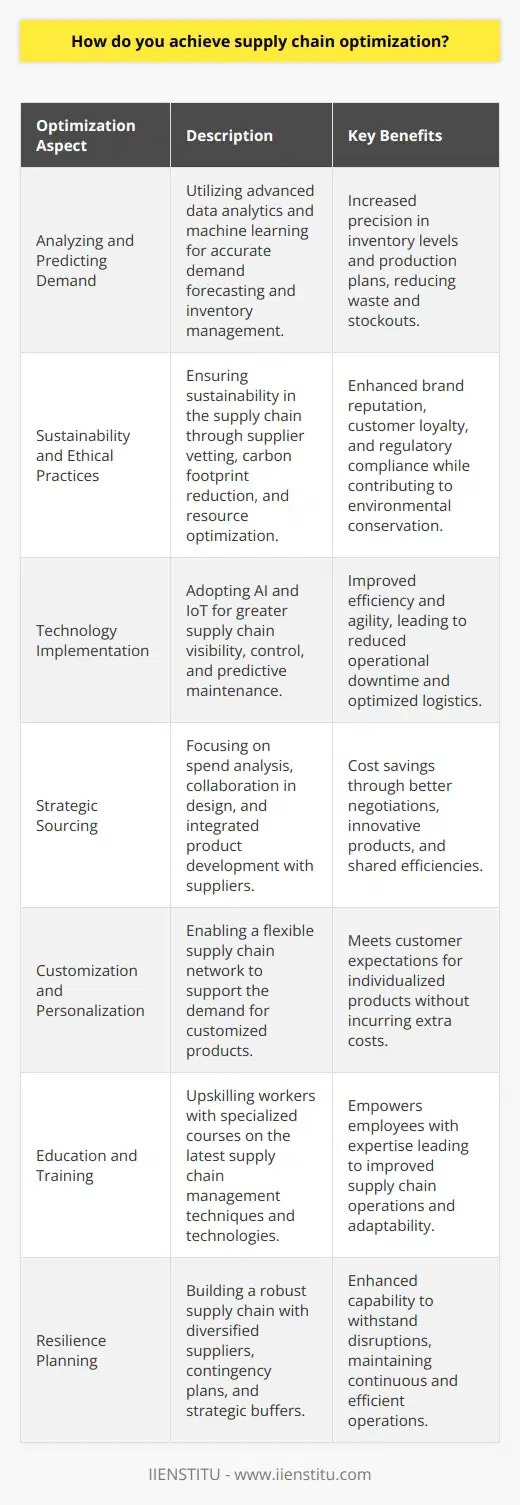
What are the 4 types of supply chain strategies?
Four Types of Supply Chain Strategies
**1. Lean Strategy**
A lean supply chain strategy prioritizes cost and efficiency, aiming to reduce waste and streamline operations through continuous improvement initiatives. This approach often relies on established metrics to measure success, such as inventory levels, cycle times, and overall system costs. By employing lean principles, businesses can focus on minimizing overhead and improving the flow of information and products, leading to a more agile and responsive supply chain.
**2. Agile Strategy**
An agile supply chain strategy focuses on enhancing flexibility and responsiveness in order to adapt to ever-changing market conditions. This approach emphasizes collaboration among supply chain partners, allowing for quick decision-making and rapid adjustments to fluctuations in customer demand. Agile strategies typically involve modular product designs, decentralized decision-making, and advanced IT systems to support real-time communication and data sharing. The end goal is to create a supply chain capable of responding quickly to changes, ultimately leading to higher customer satisfaction and increased competitiveness.
**3. Hybrid Strategy**
A hybrid supply chain strategy combines elements of both lean and agile approaches to create a balanced system that can address various challenges. In this model, businesses strive to maintain efficiency and cost-effectiveness while still prioritizing flexibility and adaptability. A hybrid approach may involve implementing lean processes in certain stages of the supply chain, while maintaining agile operations in other stages. This allows organizations to capitalize on the strengths of each strategy, effectively balancing the trade-offs between cost efficiency and responsiveness.
**4. Customized Strategy**
A customized supply chain strategy is tailored to a specific business or industry, taking into account unique challenges and opportunities present in that context. Customized strategies consider factors such as customer preferences, product lifecycles, and regulatory requirements to create a targeted approach that aligns with the organization's overall strategy and objectives. By adapting supply chain processes and structures to the specific context, businesses can enhance their competitive edge and ensure long-term success.
In conclusion, the four types of supply chain strategies – lean, agile, hybrid, and customized – offer different approaches to managing and optimizing supply chain operations. Each strategy has its merits and is best suited to different business contexts, goals, and challenges. Ultimately, choosing the right supply chain strategy will enable organizations to enhance efficiency, adaptability, and competitiveness in today's complex global market.
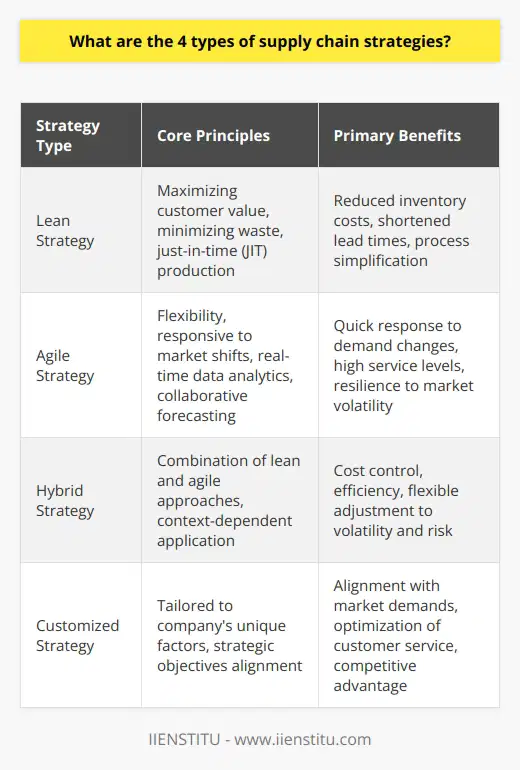
What are the 5 basic components of supply chain management?
Components of Supply Chain Management
Planning:
The first component of supply chain management is planning, which involves the development of a strategy for effectively managing resources and processes. This step requires analyzing customer needs, designing distribution networks, and determining resource requirements.
Sourcing:
Sourcing is the second component and refers to selecting suppliers who provide goods and services required to meet customer needs. It includes negotiating contracts, monitoring supplier performance, and evaluating the quality of materials or services provided.
Manufacturing:
Manufacturing, the third component, deals with the production or assembly of goods to meet customer demands. The manufacturing process can include design, engineering, assembly, testing, and packaging. Efficient manufacturing processes are crucial for maintaining product quality and reducing lead times.
Delivery and Logistics:
An essential component of supply chain management is delivery and logistics. This aspect involves the transportation, warehousing, and delivery of goods to customers. Effective delivery systems ensure the timely and cost-efficient movement of goods from manufacturers to consumers.
Returns Management:
Lastly, returns management is a necessary aspect of supply chain management that is often overlooked. This component deals with handling the return of defective, damaged, or unsold products. It is essential to have efficient returns management to maintain customer satisfaction, minimize costs associated with product returns, and support sustainability goals.
